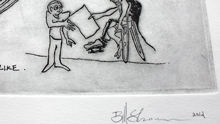TShirts, Stickers, Prints, Art Objects
WhatIsWhat 1.0 2003
"Work It Out" vs. "Flow" Dance For Camera
These two projects featuring my dance work on crutches held much in common. They were both dance for camera projects involving dancing and skating through an urban environment while staying in range and in frame for a steady-cam operator who followed each movement to the best of their ability. Both projects involved collaborating with director Joey Garfield and since their completion both have received overwhelmingly positive reactions by their respective audiences.
above: see hd here updated 2015 https://youtu.be/3m5kC_t5IGo Music Video: Artist: RJD2 Track "Work It Out" Direction Joey Garfield, Choreography and Performance Bill Shannon 2007
above: Ad Campaign: Visa "Flow" Europe, Direction Joey Garfield, Choreography and Performance Bill Shannon 2009
Visa "Flow" making of shows some outtakes
The primary difference between the two projects is that Work It Out was a one day low budget music video shot and released as a single take. Flow was a big budget advertisement shot over several days and released as a heavily edited sequence. Flow was based on Work It Out and came two years later.
The reason for the comparison is that I wanted to point out how much of a difference it makes as a dancer to control the time. While the Flow video shows some real eye-candy moves and an unprecedented capture of my gliding technique it erases within the creative process the connection my dancing has to the music and the way my dancing uses time. Work it Out succeeds in communicating my dance as an art form as opposed to a very cooly produced series of slick moves. In the RJD2 it was my choreography that made the video what it was. I chose the freeze on top of the garbage can right when the first chorus Take It Easy hits, I chose to open the take with the spin down the stairs, I felt the beauty in the sun with my arms raised to the sky while rolling on the skateboard, I felt the wallride, instinctually navigated the avoidance of the pedestrians and hit the pole freeze, the hidden face bow, and the low-mid stair climb at the ending.. all as a stream of physical and mental consciousness. Thus in my opinion the RJD2 music video is a better representation of my work as an artist. That said, what the Flow video brings with its big budgetness is an unprecedented ability to track the glide, the railslide and simply keep everything really tight. The edits of the dancing itself however leave me scratching my head in a few parts. Basically slaughtering the dance move transitions from in the saddle to hi-mid or from hi-mids back into saddle. The pacing of the feet was also switching up between the glide and a more pedestrian uprock. For the lay viewer however I think those details and incongruities were invisible. The fact that the Flow ad used a very funky Don Thomas, Northern Soul track to back the dance helped overcome this alienation of my dance to the music to some degree. The RJD2 track was a good track and I was able to work with it but listening to the northern soul Don Parton track was like having a highly addictive drug injected into your ear. In the end each video has it strengths and weaknesses. I am happy with the results of both and am relieved to have recorded my dance in urban space for all time on such a high level. I am especially grateful to Joey Garfield for his belief in my dancing that brought this all about. My artistic interpretation of music through time and space was preserved by the RJD2 music video while the slickness and sickness of my dance in urban space was crystallized in the Flow video.
below: Don Thomas, Come On Train Ian Parton Remix

This Work, "Work It Out" vs. "Flow" Dance For Camera , by Bill Shannon is licensed under a CC BY-NC-SA license.
